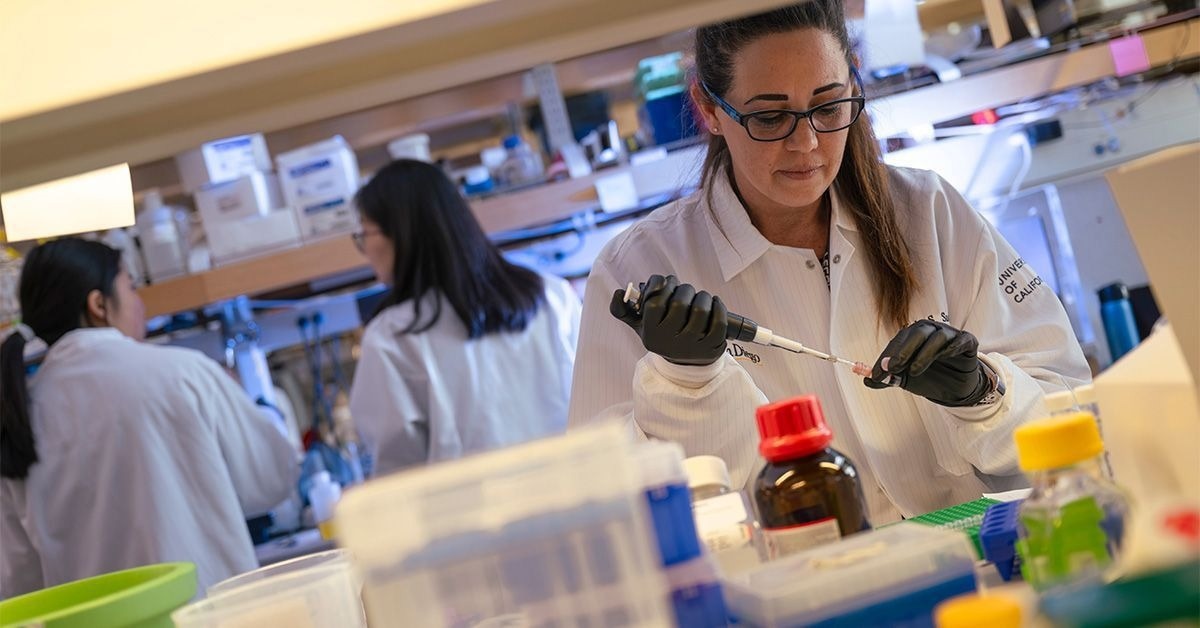Reviewed by Lexie CornerMay 7 2024
Researchers at the University of California, San Diego, have created a machine-learning system that mimics the laborious chemistry required in the initial stages of drug discovery. This development might greatly expedite the process and pave the way for previously undiscovered therapies. The research was published in the journal Nature Communications.
 Study co-author Katherine Licon, photographed here at the bench, is the lab manager for the Ideker Lab at UC San Diego, which combines computational and traditional wet-lab techniques to answer fundamental questions about disease biology and discover new ways to enhance precision medicine. Image Credit: Erik Jepsen/University of California
Study co-author Katherine Licon, photographed here at the bench, is the lab manager for the Ideker Lab at UC San Diego, which combines computational and traditional wet-lab techniques to answer fundamental questions about disease biology and discover new ways to enhance precision medicine. Image Credit: Erik Jepsen/University of California
While thousands of individual tests are usually required to identify candidate medications for further improvement, the new artificial intelligence (AI) platform may be able to produce the same findings in a quarter of the time. The researchers utilized the new instrument to create 32 novel cancer treatment options.
The technology is part of an emerging movement in pharmaceutical science that aims to enhance medication development and discovery through artificial intelligence.
A few years ago, AI was a dirty word in the pharmaceutical industry, but now the trend is the opposite. With biotech startups finding it difficult to raise funds without addressing AI in their business plan, AI-guided drug discovery has become a very active area in the industry, but unlike the methods being developed in companies, we are making our technology open source and accessible to anybody who wants to use it.
Trey Ideker, Professor, Study Senior Author, Department of Medicine, University of California
Ideker is also an Adjunct Professor of Bioengineering and Computer Science at the UC San Diego Jacobs School of Engineering.
Among AI technologies for drug development, the POLYGON platform stands out because it can uncover compounds with many targets. However, single-target therapies are currently given priority in drug discovery procedures.
Multi-target drugs are garnering significant interest from doctors and scientists due to their potential to provide comparable benefits to combination therapy, where multiple drugs are employed simultaneously to treat cancer but with reduced side effects.
It takes many years and millions of dollars to find and develop a new drug, especially if we are talking about one with multiple targets. The rare few multi-target drugs we do have were discovered largely by chance, but this new technology could help take chance out of the equation and kickstart a new generation of precision medicine.
Trey Ideker, Professor, Study Senior Author, Department of Medicine, University of California
The researchers trained POLYGON using a database comprising more than a million recognized bioactive compounds and comprehensive details on their chemical characteristics and known interactions with protein targets.
POLYGON can learn from patterns discovered in the database to produce unique chemical formulae for novel candidate medications that are anticipated to possess particular qualities, such as the capacity to block particular proteins.
Just like AI is now very good at generating original drawings and pictures, such as creating pictures of human faces based on desired properties like age or sex, POLYGON can generate original molecular compounds based on desired chemical properties. In this case, instead of telling the AI how old we want our face to look, we are telling it how we want our future drug to interact with disease proteins.
Trey Ideker, Professor, Study Senior Author, Department of Medicine, University of California
To evaluate the technology, the researchers employed POLYGON to produce hundreds of potential medications that target different pairs of cancer-related proteins. The scientists created 32 compounds with the strongest predicted interactions with the mTOR and MEK1 proteins.
MEK1 and mTOR are two cellular signaling proteins that are promising targets for cancer combination therapy. These two proteins are referred to as synthetically deadly—blocking both of them simultaneously can kill cancer cells, even if inhibiting one alone is not.
The compounds the researchers produced exhibited strong inhibitory effects on mTOR and MEK1 but negligible side effects with other proteins. This implies that one or more of the medications found by POLYGON may be able to target both proteins to treat cancer, offering a range of options for further development by human chemists.
Once you have the candidate drugs, you still need to do all the other chemistry it takes to refine those options into a single, effective treatment. We cannot and should not try to eliminate human expertise from the drug discovery pipeline, but what we can do is shorten a few steps of the process.
Trey Ideker, Professor, Study Senior Author, Department of Medicine, University of California
The researchers are optimistic that the possibilities of AI for drug discovery are only just being explored.
Ideker said, “Seeing how this concept plays out over the next decade, both in academia and in the private sector, is going to be very exciting. The possibilities are virtually endless.”
The study’s Co-authors included Brenton Munson, Michael Chen, Audrey Bogosian, Jason Kreisberg, Katherine Licon, Abagyan Ruben, and Brent Kuenzi, all of whom are at UC San Diego.
This study was sponsored by the National Institutes of Health.
Journal Reference:
Munson, B. P., et al. (2024) De novo generation of multi-target compounds using deep generative chemistry. Nature Communications. doi.org/10.1038/s41467-024-47120-y.